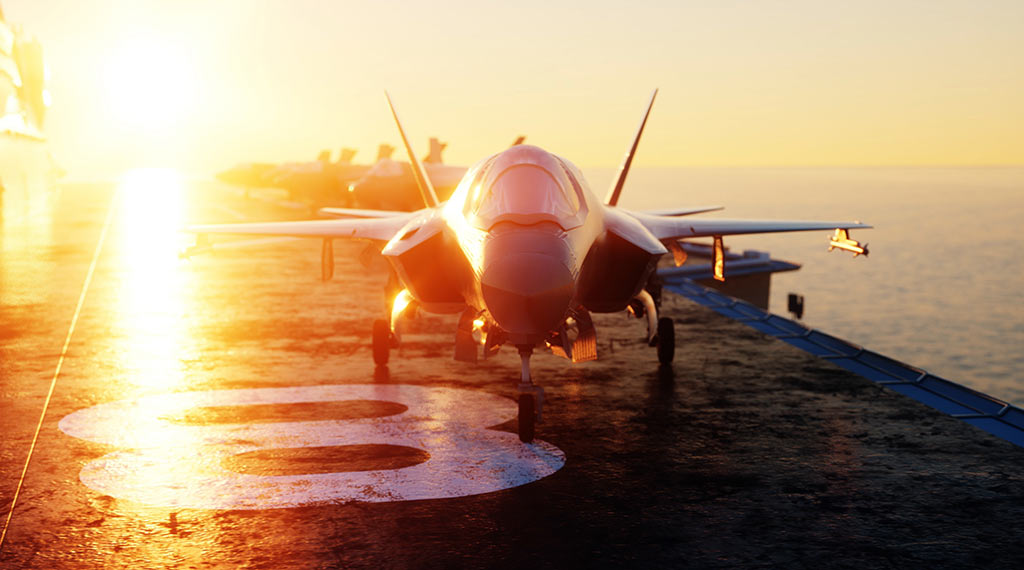
Meet the F-35C: Modern military aviation is a process of constant design, adaptation, and evolution. This process was alive and well in the U.S. in the 1980s and 1990s, with several programs running concurrently. The U.S. Air Force sought to replace the F-16 with its Multi-Role Fighter program. The Navy wanted to upgrade its A6 attack aircraft and F-14 fighter interceptors, with both programs eventually combined into the Advanced Fighter-Attack program.
Secretive Skunk Works projects such as the Advanced Short Take-off/Vertical Landing (STOVL) and Supersonic STOVL Fighter hoped to provide the Marine Corps with an advanced variant of the Harrier jump-jet. As the Cold War wound down and the Department of Defense conducted budget reviews, these programs were all consolidated into the Joint Strike Fighter (JSF).
After its consolidation, the Joint Strike Fighter considered the many capabilities requested by each service. Lockheed Martin focused on the primary goal to incorporate modern information technology into a stealth design, developing a fifth-generation fighter, the F-35 Lightning II Joint Strike Fighter, whose variants across the services shared important commonalities.
Fifth-Generation Fighters
Using advanced radar-absorbent materials, an internal weapons bay, and careful shaping of certain surfaces – most notably the engine intakes – the F-35 achieves near-parity with the F-22 when it comes to stealth. The F-22 also provided lessons to help make the aircraft’s skin better and require less maintenance.
Furthermore, designers planned for future developments in air combat.
They equipped the F-35 with an advanced sensor and data processing suite that allows pilots to receive high-level data about the battlespace – data that is also relayed to relevant parties such as other aircraft, ships, and surface assets.
In addition, the F-35 possesses capabilities that allow it to link with unmanned systems, using the vast array of information it collects to perform multiple missions managed by one operator.
In order for pilots to stay focused in this high-information environment, Lockheed Martin developed the Helmet & Pilot Interface, giving the pilot fantastic situational awareness and ability to manage the battlespace. This unique technology allows the pilot to see anywhere – even down between their feet.
F-35C, the “Charlie”
The various services of the U.S. Armed Forces had not flown the same platform for decades.
In the mid-1960s, it was the F-4 Phantom, the “Flying Anvil” over the skies of Vietnam that could be piloted by a sailor, an airman, or a marine. With the advent of the JSF, however, there is once again an interservice fighter. Like the F-4, the F-35 comes in different variants for the different services, and the differences among the variants are much more marked.
The F-35C, or “Charlie,” is the variant designed and produced for the Navy.
The primary challenge facing the F-35Cs designers was how to make it capable of carrier operations such as catapult take-off and arrested landing, or CATOBAR. Aircraft undergoing CATOBAR operations are subjected to significant stresses that other aircraft do not experience.
Perhaps the most important modification to the F-35C is the tailhook, which, along with beefier landing gear, allows it to perform arrested landings on carriers. These landings often require the aircraft to fly at slower speeds than their counterparts that have 10,000-foot runways.
The F-35C has larger flight control surfaces to allow it to remain stable on its slower approach to the carrier.
In addition to larger control surfaces, the F-35C boasts the greatest wingspan of any F-35 variant, at 43 feet, compared to the 35 feet of the A and B variants. The increased area that goes along with this greater wingspan allows the F-35C to fly at the lower approach speeds required for carrier landings, with no sacrifice in range or payload. Range is an important factor for naval aircraft, which often operate from ships far from any friendly landing field – or indeed, any land at all.
The Charlie is equipped for long range, blue-water operations thanks to a larger internal fuel tank than the A or B.
The final challenge facing designers was space. Although modern U.S. carriers are quite large, the space for storage is limited, both on deck and below in the hangar bays. To reduce its footprint and squeeze more of these fighters onboard carriers, the F-35C comes with folding wings that allow it to squeeze into the tight spots available in the hangar.
With these modifications, the F-35C is ready to go to sea aboard U.S. carriers representing American interests around the globe.
- U.S. Carrier Strike Groups Have Struck 800 Targets in Yemen - April 30, 2025
- The U.S. Is Boosting Its Middle East Military Posture - April 22, 2025
- Why America Needs Its Own Iron Dome Air Defense - April 10, 2025
